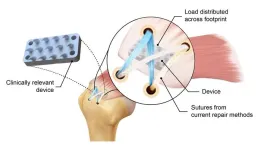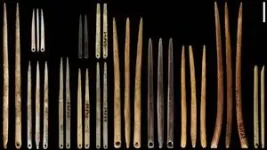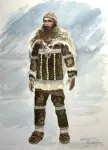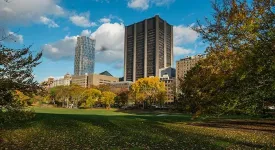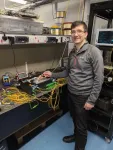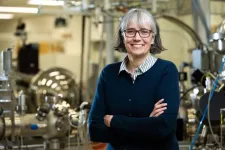(Press-News.org) New York, NY—June 24, 2024—Most people, when they think about pythons, visualize the huge snake constricting and swallowing victims whole. But did you know that pythons initially hold onto their prey with their sharp, backward-curving teeth? Medical researchers have long been aware that these teeth are perfect for grasping soft tissue rather than cutting through it, but no one has yet been able to put this concept into surgical practice. Over the years, mimicking these teeth for use in surgery has been a frequent topic of discussion in the lab of Dr. Stavros Thomopoulos, a professor of orthopedics and biomedical engineering at Columbia University.
Biomimicry key to new study
A leading researcher focused on the development and regeneration of the tendon-to-bone attachment, Thomopoulos is particularly interested in advancing tendon-to-bone repair, necessary for rotator cuff repair and anterior cruciate ligament reconstruction. In a paper published today by Science Advances, his team reports that they have developed a python-tooth-inspired device as a supplement to current rotator cuff suture repair, and found that it nearly doubled repair strength.
“As we grow older, more than half of us will experience a rotator cuff tear leading to shoulder pain and decreased mobility,” said Thomopoulos, who has joint appointments at Columbia Engineering and Columbia’s Vagelos College of Physicians and Surgeons as the Robert E. Carroll and Jane Chace Carroll Professor of Biomechanics (in Orthopedic Surgery and Biomedical Engineering). “The best medical intervention is rotator cuff surgery, but a remarkably high percentage of these repairs will fail within just a couple of months. Our biomimetic approach following the design of python teeth helps to reattach tendons to bone more securely. The device not only augments the strength of the repair but can also be customized to the patient. We’re really excited about the potential of our device to improve the care of rotator cuff injuries.”
Rotator cuff injuries
Among the most prevalent tendon injuries, rotator cuff tears affect more than 17 million people in the United States each year. The incidence of injury increases with age: more than 40% of the population over 65 years old experience a rotator cuff tear.
Because rotator cuff tears typically occur at the tendon-to-bone insertion site, rotator cuff repair is aimed at anatomically restoring the tendon attachment. Surgical repair is the primary treatment for restoring shoulder function, with more than 600,000 procedures performed annually in the United States at a cost of $3 billion.
However, successfully reattaching tendon to bone remains a significant clinical challenge. High failure rates occur following surgery, with rates increasing with patient age and tear severity. These rates range from 20% in younger patients with minor tears to a staggering 94% in elderly patients with massive tears. The most common failure of rotator cuff repairs is sutures tearing through the tendon at the two or four grasping points where forces concentrate.
While there have been advancements in rotator cuff repair techniques over the past 20 years, the fundamental approach of sewing two tissues together has remained largely unchanged, still relying on sutures transferring tension at high-stress grasping points. Following tendon-to-bone reattachment surgery, sutures can tear through tendons at these points of high stress, a phenomenon known as “suture pull-through” or “cheesewiring,” leading to repair-site gapping or rupturing.
“We decided to see if we could develop a device that mimics the shape of python teeth, that would effectively grasp soft tissues without tearing, and help reduce the risk of tendon re-tearing after rotator cuff repair,” said Iden Kurtaliaj, the study’s lead author and a former biomedical engineering PhD student in the Thomopoulos’ lab.
The device
The team’s original idea was to copy the shape of python teeth, but they went much further, using simulations, 3D printing, and ex vivo experiments on cadavers to explore the relationship between tooth shape and grasping vs. cutting mechanics. Kurtaliaj manufactured a range of tooth designs, optimized individual teeth, arrays of teeth, and finally a rotator cuff-specific array of teeth. The end result was a biomimetic device, made of a biocompatible resin -- an array of teeth atop a curved base -- capable of grasping, not cutting, tendon. The teeth are relatively small -- 3mm high for a human rotator cuff, about half the length of a standard staple -- so that they won’t poke through the tendon. The base can be customized via 3D printing to match the patient-specific curvature of the humeral head at the supraspinatus tendon attachment site (the most commonly torn rotator cuff tendon).
“We designed it specifically so that surgeons won’t need to abandon their current approach--they can simply add the device and increase the strength of their repair,” Kurtaliaj noted.
The team
Kurtaliaj led the research as a PhD student under the mentorship of Drs. Stavros Thomopoulos and Guy Genin, the Harold and Kathleen Faught Professor of Mechanical Engineering at Washington University in St. Louis, with input for clinical implementation from Dr. William Levine, Chair of the Department of Orthopedic Surgery at Columbia University's College of Physicians and Surgeons.
“Due to our laboratory's close collaboration with orthopedic surgeons, we were especially fortunate to get input from Dr. Levine, along with other surgeons at Columbia, throughout the device's design development process,” said Thomopoulos.
Next steps
The researchers are now working to develop a bioabsorbable version of the device that would degrade as the rotator cuff heals back to bone, further enhancing its clinical applicability. They are also preparing for a pre-submission meeting with the FDA to facilitate the transition of their device into the market.
About the Study
--The study is titled “Python-tooth-inspired fixation device for enhanced rotator cuff repair.”
--Authors are: Iden Kurtaliaj1,2,3, Ethan D. Hoppe4,5, Yuxuan Huang4,6, David Ju4,5, Jacob A. Sandler4,5, Donghwan Yoon4,5, Lester J. Smith7, Silvio Torres Betancur1, Linda Effiong1,8, Thomas Gardner1, Liana Tedesco1, Sohil Desai1, Victor Birman9, William N. Levine1, Guy M. Genin4,5,6*, Stavros Thomopoulos1,2*
1Department of Orthopedic Surgery, Columbia University
2Department of Biomedical Engineering, Columbia University
3Department of Neurosurgery, Icahn School of Medicine at Mount Sinai
4NSF Science and Technology Center for Engineering Mechanobiology, Washington University in St. Louis
5Department of Mechanical Engineering and Materials Science, Washington University in St. Louis
6Department of Biomedical Engineering, Washington University in St. Louis
7Department of Radiology and Imaging Sciences, Indiana University School of Medicine
8Koru Medical Systems, Mahwah, NJ
9Department of Mechanical and Aerospace Engineering, Missouri University of Science and Technology
--This work was supported by National Institutes of Health (R01 AR077793 and R21 AR076008) and the NSF (CMMI 1548571).
--Competing interests: Several of the authors have submitted two patent applications related to the subject of this paper: Genin G, Hoppe E, Yoon DH, Thomopoulos S, Kurtaliaj I, Tedesco L, Kovacevic D, Birman V, Smith L, Galatz L, Levine W, inventors. Soft tissue-hard tissue interface fixation device. United States patent application US 17/766,503. 2024 Feb 15; and Genin G, Hoppe E, Yoon DH, Thomopoulos S, Kurtaliaj I, Tedesco L, Kovacevic D, Birman V, Smith L, Galatz L, Levine W, inventors. Soft tissue-hard tissue interface fixation device. United States patent application US 17/932,232. 2023 Apr 13. All authors declare no other competing interests.
###
LINKS:
Paper: URL: https://www.science.org/doi/10.1126/sciadv.adl5270
DOI: 10.1126/sciadv.adl5270
END
New device inspired by python teeth doubles strength of rotator cuff repairs
Columbia University team uses biomimicry to create a device that may reduce the risk of rotator cuff re-tearing in patients
2024-06-28
ELSE PRESS RELEASES FROM THIS DATE:
The beginnings of fashion
2024-06-28
EMBARGO: 4:00 Sydney AEST June 29 | 14:00 US ET June 28 2024
The beginnings of fashion
Paleolithic eyed needles and the evolution of dress
A team of researchers led by an archaeologist at the University of Sydney are the first to suggest that eyed needles were a new technological innovation used to adorn clothing for social and cultural purposes, marking the major shift from clothes as protection to clothes as an expression of identity.
“Eyed needle tools are an important development in prehistory because they document a transition in the function of clothing from utilitarian to social purposes,” says Dr Ian Gilligan, Honorary Associate ...
Why some tumors are resistant to cell therapies
2024-06-28
FRANKFURT. In congratulating the CARISMa scientists, Goethe University President Prof. Enrico Schleiff said: “The new LOEWE network sets up in Hesse an innovative research program that is currently gathering steam all over the world. It also expands Goethe University’s existing research profile and broadens our network of cooperation partners in the field of CAR cell therapy [editor’s note: CAR is the abbreviation for chimeric antigen receptor]. The network deliberately builds on our university’s ...
Can A.I. tell you if you have osteoporosis? Newly developed deep learning model shows promise
2024-06-28
Osteoporosis is so difficult to detect in early stage it’s called the “silent disease.” What if artificial intelligence could help predict a patient’s chances of having the bone-loss disease before ever stepping into a doctor’s office?
Tulane University researchers made progress toward that vision by developing a new deep learning algorithm that outperformed existing computer-based osteoporosis risk prediction methods, potentially leading to earlier diagnoses and better outcomes for patients with osteoporosis risk.
Their results were recently published in ...
Work-related nerve injuries are common with repetitive motions
2024-06-28
Although you may not always realize it, many of the jobs you do can put strain on, and even cause damage to, your nerves.
Sandra Hearn, M.D., the associate chair of Education and Professional Development in the Department of Physical Medicine and Rehabilitation, and a team of collaborators, set out to better understand the causes of occupational nerve injuries.
What is an occupational nerve injury?
An occupational nerve injury refers to a problem with your peripheral nerves that's caused by a work-related activity. It's often seen ...
Mount Sinai study reveals significant differences in RNA editing between postmortem and living human brain
2024-06-28
Researchers from the Icahn School of Medicine at Mount Sinai have shed valuable light on the nuanced functions and intricate regulatory methods of RNA editing, a critical mechanism underlying brain development and disease.
In a study published June 26 in Nature Communications, the team reported finding major differences between postmortem and living prefrontal cortex brain tissues as they relate to one of the most abundant RNA modifications in the brain, known as adenosine-to-inosine (A-to-I) editing. This discovery will play a significant role ...
Penn researchers will investigate link between TBI and dementia with $10M NIH grant
2024-06-28
PHILADELPHIA— A team of researchers led by Penn Medicine will investigate the link between traumatic brain injuries (TBI) and Alzheimer’s disease and related dementias (ADRD) over the next five years with a $10 million grant from the National Institute of Neurological Disorders and Stroke (NINDS). Using an extensive tissue bank including over 1,000 samples, the researchers aim to uncover the underlying biological mechanisms of TBI-related neurodegeneration (TReND) from a variety of brain injury types. ...
Aston University researchers break ‘world record’ again for data transmission speed
2024-06-28
Aston Institute of Photonic Research academics are part of a team that sent data at a rate of 402 terabits per second
This beats their previous record of 301 terabits per second
They constructed the first optical transmission system covering six wavelength bands.
Aston University researchers are part of a team that has sent data at a record rate of 402 terabits per second using commercially available optical fibre.
This beats their previous record, announced in March 2024, of 301 terabits or 301,000,000 megabits per second using a single, standard optical fibre.
"If compared to the internet connection speed recommendations of Netflix, of 3 Mbit/s ...
A few surgical procedures account for high number of opioid prescriptions
2024-06-28
A handful of common surgical procedures account for large shares of all opioids dispensed after surgery in children and adults, according to two studies recently published by researchers at the University of Michigan.
The studies, published this week in Pediatrics and JAMA Network Open, report that the top three procedures for children ages 0-11 account for 59% of opioids dispensed after surgery (tonsillectomies and adenoidectomies 50%, upper extremity fractures 5% and removal of deep implants 4%). Among those ages 12-21, the top three procedures account for ...
Clemson University bioengineer receives $2.1 million SBIR grant to develop long-lasting natural disinfectants superior to currently available disinfectants
2024-06-28
Alexey Vertegel, Ph.D., Associate Professor in the Department of Bioengineering, Clemson University, has been awarded a $2.1M Small Business Innovation Research (SBIR) Phase II grant from the National Institute of Allergy and Infectious Diseases (NIAID) to develop long-lasting natural disinfectants. Currently used surface disinfectants provide high-level activity over a relatively short period of time, typically less than 4 hours. During the Phase I study, his team developed a novel film-forming disinfectant based on chitosan, alcohol, and a natural antimicrobial, which is slowly released from the ...
Elke Arenholz named director of the National Synchrotron Light Source II at Brookhaven Lab
2024-06-28
UPTON, N.Y. — Elke Arenholz, a renowned scientist known for her expertise in magnetic materials and X-ray spectroscopy, scattering, imaging, and instrument development, has been named director of the National Synchrotron Light Source II (NSLS-II), a U.S. Department of Energy (DOE) Office of Science user facility at DOE’s Brookhaven National Laboratory, effective August 2024.
Arenholz’s appointment comes following a search that began in summer 2023 after John Hill, the previous director of NSLS-II, ...
LAST 30 PRESS RELEASES:
Researchers identify gene that calms the mind and improves attention in mice
Artificial metabolism turns waste CO2 into useful chemicals
Ancient sea anemone sheds light on animal cell type evolution
Begging gene leads to drone food
How climate policies that incentivize and penalize can drive the clean energy transition
Can community awareness campaigns in low-resource areas improve early diagnosis of colorectal cancer?
Stardust study resets how life’s atoms spread through space
Practical education: Clinical scenario-based program development
The impact of family dynamics on eating behaviour – how going home for Christmas can change how you eat
Tracing the quick synthesis of an industrially important catalyst
New software sheds light on cancer’s hidden genetic networks
UT Health San Antonio awarded $3 million in CPRIT grants to bolster cancer research and prevention efforts in South Texas
Third symposium spotlights global challenge of new contaminants in China’s fight against pollution
From straw to soil harmony: International team reveals how biochar supercharges carbon-smart farming
Myeloma: How AI is redrawing the map of cancer care
Manhattan E. Charurat, Ph.D., MHS invested as the Homer and Martha Gudelsky Distinguished Professor in Medicine at the University of Maryland School of Medicine
Insilico Medicine’s Pharma.AI Q4 Winter Launch Recap: Revolutionizing drug discovery with cutting-edge AI innovations, accelerating the path to pharmaceutical superintelligence
Nanoplastics have diet-dependent impacts on digestive system health
Brain neuron death occurs throughout life and increases with age, a natural human protein drug may halt neuron death in Alzheimer’s disease
SPIE and CLP announce the recipients of the 2025 Advanced Photonics Young Innovator Award
Lessons from the Caldor Fire’s Christmas Valley ‘Miracle’
Ant societies rose by trading individual protection for collective power
Research reveals how ancient viral DNA shapes early embryonic development
A molecular gatekeeper that controls protein synthesis
New ‘cloaking device’ concept to shield sensitive tech from magnetic fields
Researchers show impact of mountain building and climate change on alpine biodiversity
Study models the transition from Neanderthals to modern humans in Europe
University of Phoenix College of Doctoral Studies releases white paper on AI-driven skilling to reduce burnout and restore worker autonomy
AIs fail at the game of visual “telephone”
The levers for a sustainable food system
[Press-News.org] New device inspired by python teeth doubles strength of rotator cuff repairsColumbia University team uses biomimicry to create a device that may reduce the risk of rotator cuff re-tearing in patients
